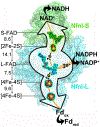Mechanistic insights into energy conservation by flavin-based electron bifurcation
- PMID: 28394885
- PMCID: PMC7646311
- DOI: 10.1038/nchembio.2348
Mechanistic insights into energy conservation by flavin-based electron bifurcation
Abstract
The recently realized biochemical phenomenon of energy conservation through electron bifurcation provides biology with an elegant means to maximize utilization of metabolic energy. The mechanism of coordinated coupling of exergonic and endergonic oxidation-reduction reactions by a single enzyme complex has been elucidated through optical and paramagnetic spectroscopic studies revealing unprecedented features. Pairs of electrons are bifurcated over more than 1 volt of electrochemical potential by generating a low-potential, highly energetic, unstable flavin semiquinone and directing electron flow to an iron-sulfur cluster with a highly negative potential to overcome the barrier of the endergonic half reaction. The unprecedented range of thermodynamic driving force that is generated by flavin-based electron bifurcation accounts for unique chemical reactions that are catalyzed by these enzymes.
Conflict of interest statement
Competing financial interests
The authors declare no competing financial interests.
Figures




Similar articles
-
An uncharacteristically low-potential flavin governs the energy landscape of electron bifurcation.Proc Natl Acad Sci U S A. 2022 Mar 22;119(12):e2117882119. doi: 10.1073/pnas.2117882119. Epub 2022 Mar 15. Proc Natl Acad Sci U S A. 2022. PMID: 35290111 Free PMC article.
-
Distinct properties underlie flavin-based electron bifurcation in a novel electron transfer flavoprotein FixAB from Rhodopseudomonas palustris.J Biol Chem. 2018 Mar 30;293(13):4688-4701. doi: 10.1074/jbc.RA117.000707. Epub 2018 Feb 9. J Biol Chem. 2018. PMID: 29462786 Free PMC article.
-
Contrasting roles for two conserved arginines: Stabilizing flavin semiquinone or quaternary structure, in bifurcating electron transfer flavoproteins.J Biol Chem. 2022 Apr;298(4):101733. doi: 10.1016/j.jbc.2022.101733. Epub 2022 Feb 15. J Biol Chem. 2022. PMID: 35176283 Free PMC article.
-
Flavins in the electron bifurcation process.Arch Biochem Biophys. 2021 Apr 15;701:108796. doi: 10.1016/j.abb.2021.108796. Epub 2021 Feb 18. Arch Biochem Biophys. 2021. PMID: 33609536 Review.
-
Structures and Electron Transport Paths in the Four Families of Flavin-Based Electron Bifurcation Enzymes.Subcell Biochem. 2024;104:383-408. doi: 10.1007/978-3-031-58843-3_14. Subcell Biochem. 2024. PMID: 38963493 Review.
Cited by
-
Distribution, Evolution, Catalytic Mechanism, and Physiological Functions of the Flavin-Based Electron-Bifurcating NADH-Dependent Reduced Ferredoxin: NADP+ Oxidoreductase.Front Microbiol. 2019 Mar 1;10:373. doi: 10.3389/fmicb.2019.00373. eCollection 2019. Front Microbiol. 2019. PMID: 30881354 Free PMC article. Review.
-
Low potential enzymatic hydride transfer via highly cooperative and inversely functionalized flavin cofactors.Nat Commun. 2019 May 6;10(1):2074. doi: 10.1038/s41467-019-10078-3. Nat Commun. 2019. PMID: 31061390 Free PMC article.
-
Ferredoxin reduction by hydrogen with iron functions as an evolutionary precursor of flavin-based electron bifurcation.Proc Natl Acad Sci U S A. 2024 Mar 26;121(13):e2318969121. doi: 10.1073/pnas.2318969121. Epub 2024 Mar 21. Proc Natl Acad Sci U S A. 2024. PMID: 38513105 Free PMC article.
-
Hydrogen-based metabolism as an ancestral trait in lineages sibling to the Cyanobacteria.Nat Commun. 2019 Jan 28;10(1):463. doi: 10.1038/s41467-018-08246-y. Nat Commun. 2019. PMID: 30692531 Free PMC article.
-
Two functionally distinct NADP+-dependent ferredoxin oxidoreductases maintain the primary redox balance of Pyrococcus furiosus.J Biol Chem. 2017 Sep 1;292(35):14603-14616. doi: 10.1074/jbc.M117.794172. Epub 2017 Jul 13. J Biol Chem. 2017. PMID: 28705933 Free PMC article.
References
-
- Buckel W & Thauer RK Energy conservation via electron bifurcating ferredoxin reduction and proton/Na+ translocating ferredoxin oxidation. Biochimica et Biophysica Acta 1827, 94–113 (2013). - PubMed
-
- Mitchell P The Protonmotive Q Cycle: A General Formulation. FEBS Letters 59, 137–139 (1975). - PubMed
-
- Peters JW, Miller A-F, Jones AK, King PW & Adams MW Electron bifurcation. Current Opinions in Chemical Biology 31 (2016). - PubMed
-
- Brandt U Bifurcated ubihydroquinone oxidation in the cytochrome bc1 complex by proton-gated charge transfer. FEBS Letters 387, 1–6 (1996). - PubMed
Publication types
MeSH terms
Substances
Grants and funding
LinkOut - more resources
Full Text Sources
Other Literature Sources

